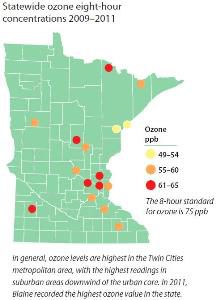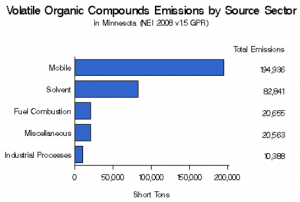Volatile Organic Compounds (VOCs) – A Type of Air Pollution
 Minnesota is currently in compliance with the National Ambient Air Quality Standard (NAAQS), but compliance does not mean our air is clean and hazard free. The NAAQS for ozone is considered for revision every five years, and the EPA recently proposed lowering the standard to make the country’s air safer. There are areas of Minnesota that could go out of compliance if the standard is lowered. If that happens sources of VOC emissions will be affected at the end of a six year process (2020) to develop and implement new rules. The figure to the right shows monitoring stations that are representative of larger areas that are at risk (red dots are likely, orange are possibilities).
Minnesota is currently in compliance with the National Ambient Air Quality Standard (NAAQS), but compliance does not mean our air is clean and hazard free. The NAAQS for ozone is considered for revision every five years, and the EPA recently proposed lowering the standard to make the country’s air safer. There are areas of Minnesota that could go out of compliance if the standard is lowered. If that happens sources of VOC emissions will be affected at the end of a six year process (2020) to develop and implement new rules. The figure to the right shows monitoring stations that are representative of larger areas that are at risk (red dots are likely, orange are possibilities).
What are VOCs?
 Volatile Organic Compounds (VOCs) are a large group of carbon-based chemicals that easily evaporate at room temperature. VOCs react in the atmosphere with nitrogen oxides (NOx) to create ozone and some very fine particulates. Ozone and particulates are the primary components of smog. Because ozone is formed in the atmosphere, it can be created at some distance from the original VOC and NOx sources and formation is weather dependent.
Volatile Organic Compounds (VOCs) are a large group of carbon-based chemicals that easily evaporate at room temperature. VOCs react in the atmosphere with nitrogen oxides (NOx) to create ozone and some very fine particulates. Ozone and particulates are the primary components of smog. Because ozone is formed in the atmosphere, it can be created at some distance from the original VOC and NOx sources and formation is weather dependent.
VOCs:
- Are found in many products and materials including adhesives, paint, fragrances, fuels and solvents like butane, toluene, acetone, formaldehyde, and methyl ethyl ketone
- Are released through product and material use as well as manufacture
- Include both regulated and non-regulated compounds
 The chart at left shows the man-made sources of VOCs in Minnesota. Mobile sources (cars and trucks) are the largest source. Solvent use is next and comes from a range of personal, industrial and commercial uses. Fuel combustion, the third largest source, is the heating of buildings and industrial processes. Miscellaneous includes gas stations, petroleum terminals and cooking,Lastly, the industrial category includes all other industrial VOC releases not accounted for in the solvent and combustion categories.
The chart at left shows the man-made sources of VOCs in Minnesota. Mobile sources (cars and trucks) are the largest source. Solvent use is next and comes from a range of personal, industrial and commercial uses. Fuel combustion, the third largest source, is the heating of buildings and industrial processes. Miscellaneous includes gas stations, petroleum terminals and cooking,Lastly, the industrial category includes all other industrial VOC releases not accounted for in the solvent and combustion categories.